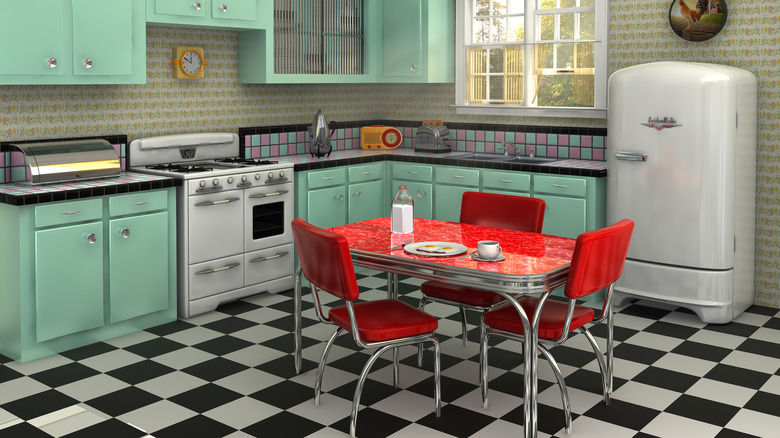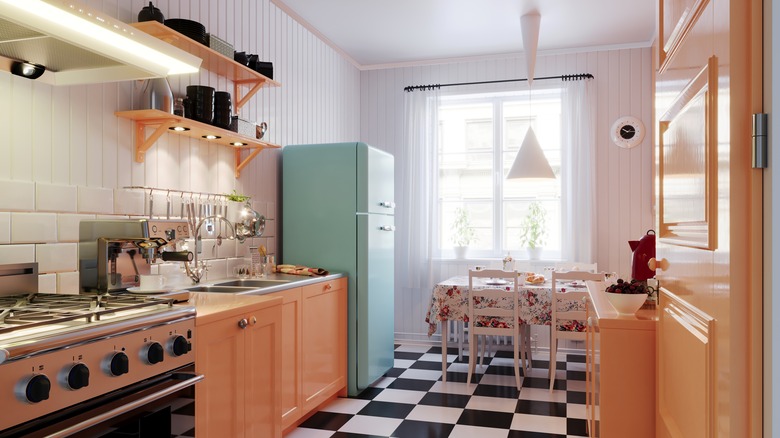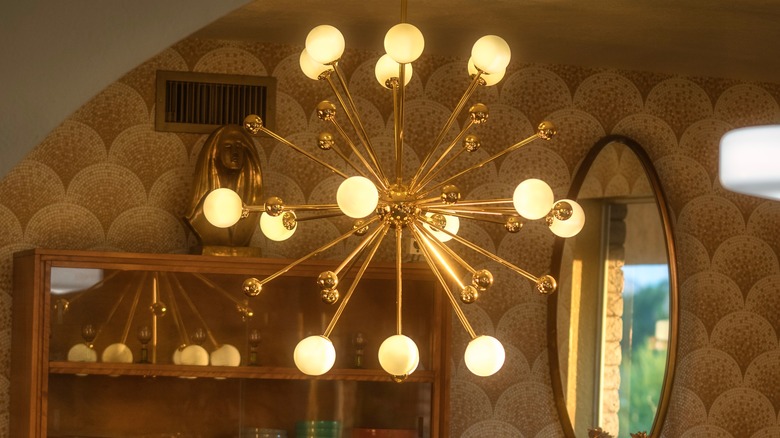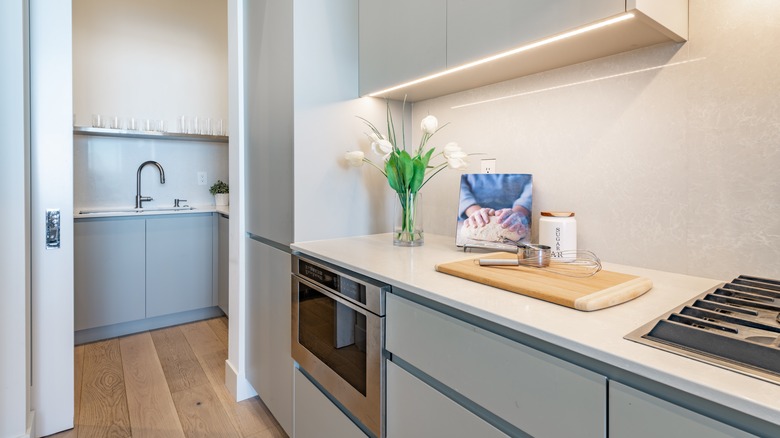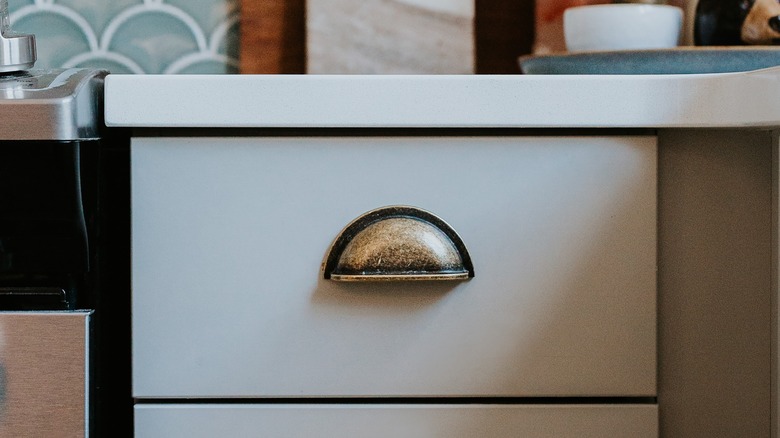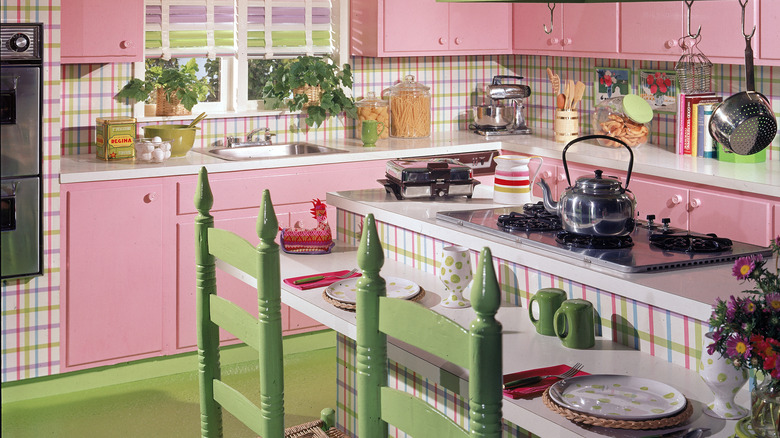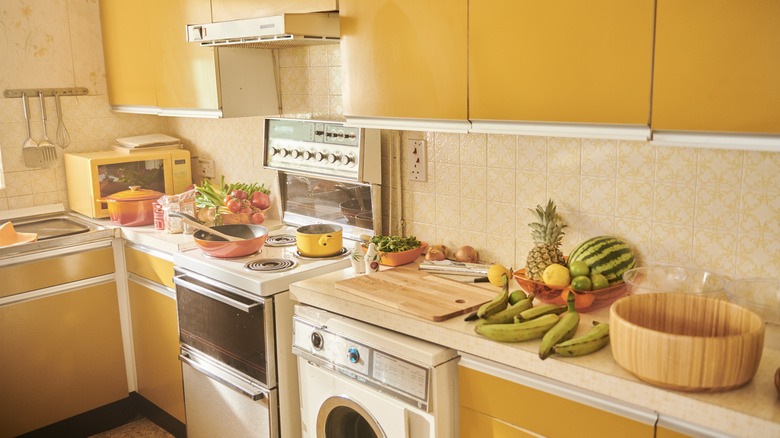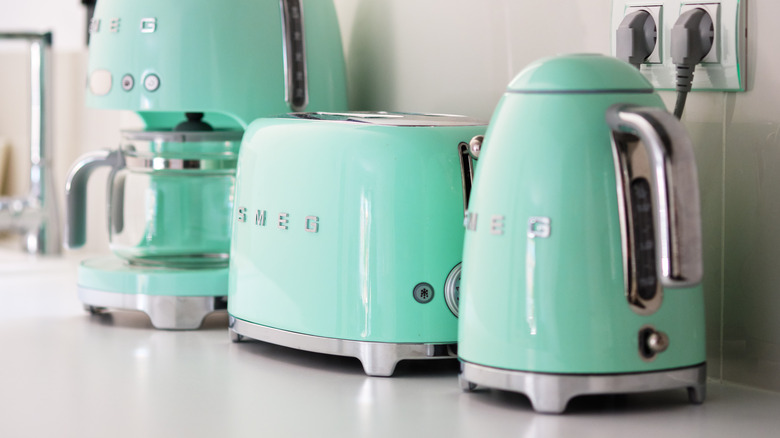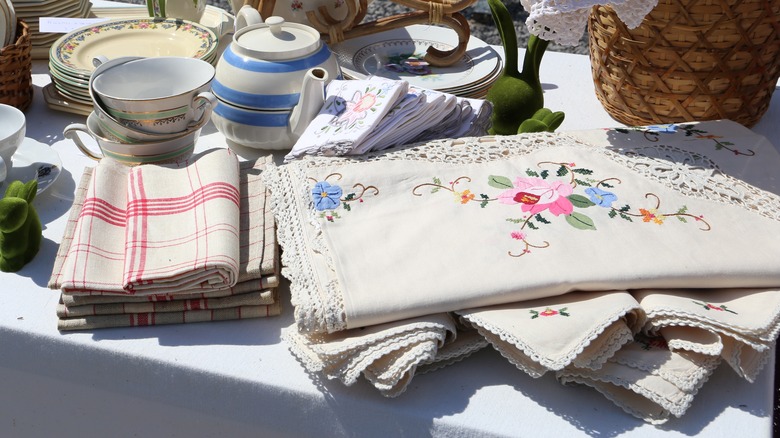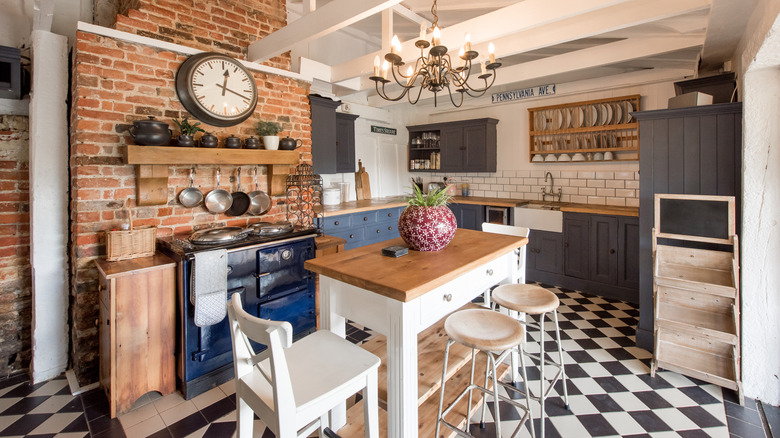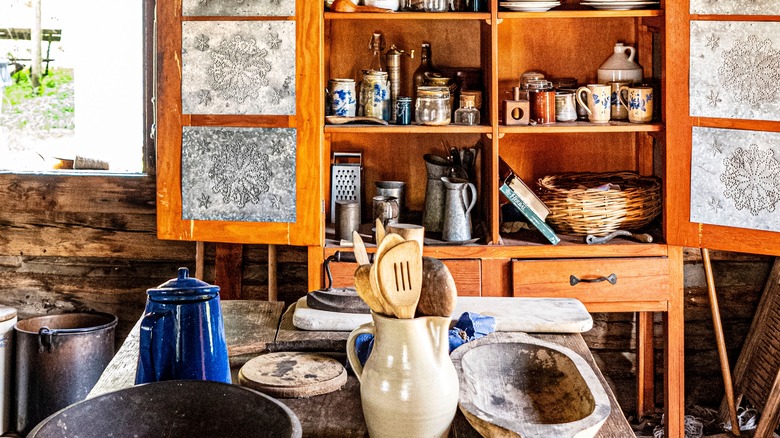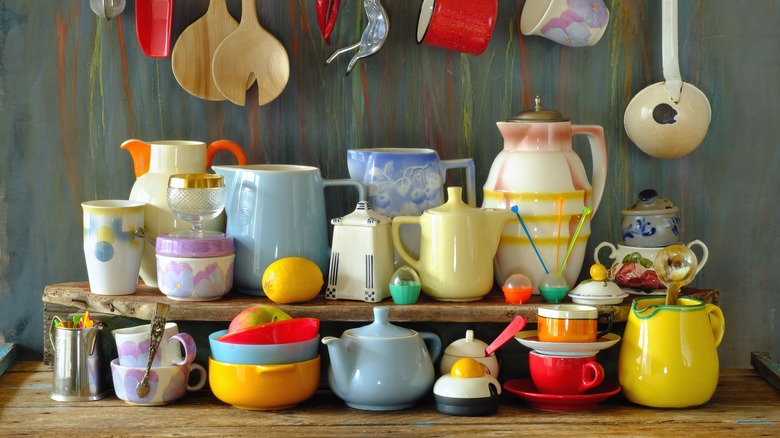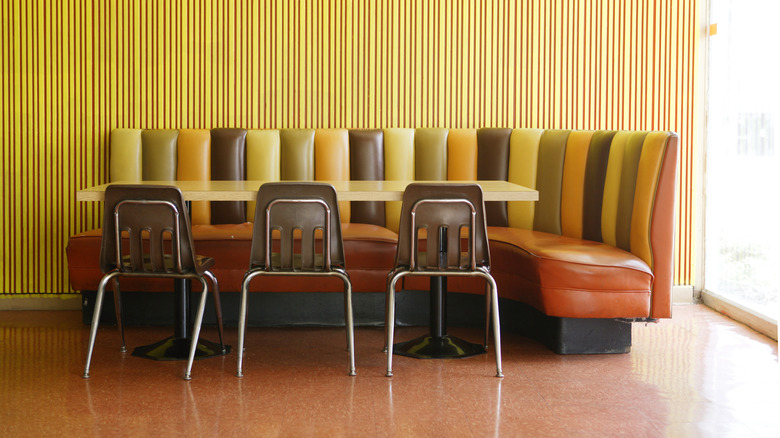These 14 Retro Kitchen Designs Should Make A Comeback
Kitchen trends are always evolving, ever shifting as families' and homeowner's needs change. Some kitchen designs are merely fads, quickly falling out of vogue in a handful of years, while others withstand the test of time. Instead of falling for trendy styles, one of the best strategies to build an enduring kitchen design is to look to the past, rediscovering classic design elements that can be reimagined in unique ways.
While retro food trends are remerging, so are vintage kitchen designs, adding charm and nostalgia to these central spaces. Be you looking for low-commitment decor changes or full layout redesigns, there are many means to introduce some vintage enthusiasm into your cooking space, borrowing elements from multiple eras or a single period. The best approach to ensure you love your kitchen for years to come is to lean into design trends that speak to you, be they Victorian-era china cabinets or mid-century style bar stools.
Vivid color schemes
For years, neutral hues have been a defining feature of kitchen designs, but this trend is soon to pass. It's time for energetic color palettes like those of the '60s and '70s to replace more bland ones, infusing plenty of nostalgic character into kitchen spaces. Hues like avocado green and atomic-era colors, such as blues and orange, seem to be making a particularly big comeback. Quickly fading are those all-white kitchens of the aughts — a design trend that actually dates back to the Spanish flu epidemic of 1918, when recreating sanitary spaces was all the rage.
The 1960s colors like sunshine yellow and bold orange insert personality into kitchen spaces, be they via an accent wall or a simple colorful pop of color on the countertop. Likewise, color palettes of the atomic age, like turquoise and flamingo pink, add a playful quality, lending spaces an energetic spirit. Some are also welcoming bold single-color kitchens, like retro all-pink "kitsch-ens." This warmly nostalgic hue can brighten up cooking spaces, be it embraced wholeheartedly via pink cabinets and pink walls or blended with other shades.
Retro-era lights
It's about time for kitchen lighting to be aesthetically pleasing as well as practical. The days of generic pot lighting are fading into the past to be succeeded by unique light fixtures that evoke a timeless feel. More and more kitchen designs seem to be incorporating old-school lighting fixtures, oftentimes saving these spectacular, retro designs from landfills. Vintage glass lighting is a classic choice for a polished yet ageless feel that won't feel dated in a few years. While you can opt for true vintage lighting, having it rewired for modern homes, you may also seek out modern fixtures with a nostalgic atmosphere, embracing the best of both worlds.
Sculptural and rattan lighting features are ready to make a fashionable return, with barstools and seating echoing these vintage vibes. The earthy, airy rattan trend calls to mind homes of the 1960s and '70s, interspersing a natural character that can balance out harsh lines and metals with a softness. Retro lighting, like mid-century modern pendants and boldly colored light fixtures, are a great way to set a vintage tone for your cooking space, adding visual interest to ensure your kitchen's lighting is much more than just functional.
Closed concept designs and secondary kitchen spaces
Kitchen spaces often take center stage during cocktail parties and home entertaining, and as more people continue to cook and entertain at home, it's probable these spaces will begin to adapt, incorporating more old-school layouts into the mix. While open-concept kitchens still dominate many floor plans, shifts towards a second kitchen prep space to keep the mess of entertaining out of sight have long called for a revival. While this feature has recently been displayed as a separate wet bar for a front-entertaining space with appliances hidden away in a rear cooking space, it is likely the coming years will lean further into this layout with the resurgence of butler's pantries and scullery-type kitchen areas to keep the clutter out of sight and open up a specified kitchen area for entertaining.
Once a feature within wealthy homes, a scullery was a smaller room, often adjacent to the larger kitchen, where food prep and cleaning took place. Today, these old-fashioned areas are ideal places to store kitchenware and countertop appliances in addition to dirty dishes. While sculleries typically had sinks, butler's pantries did not. The focus of the butler's pantry was to store tableware and plate food for serving.
As this trend towards secondary kitchen spaces further develops, some foresee a return to closed-concept kitchens resurfacing again, further sheltering kitchen aromas as well as kitchen messes from prying eyes. Another benefit to a separated kitchen area? This also allows for more unique design choices to occur within each space, as you no longer have to worry whether your open concept kitchen design will match the rest of your attached living space.
Hardware with heritage
From matte brass to mismatched metals, vintage hardware is a design heavily poised for a revival. Brass in particular remains an old-school hardware choice that many are eagerly welcoming once again. Unlacquered brass, which bestows much more of a lived-in feel, adds a warm, comforting vibe to kitchen cabinets and fixtures. With vintage hardware mixing metals is absolutely permissible, meaning aged copper drawer pulls can pair with a matte black faucet or stainless steel with a worn patina.
While the brass hardware trend was popular during the 1980s, a more relaxed mood can be achieved by choosing a less polished version of this classic metal. Both brass and copper were fashionable in Victorian-era kitchens, but this look is best achieved with metals that have a less shiny character, offering a more old-world feel. If you're looking for a new look for cabinet hardware, drawer pulls, or even a new faucet, consider revisiting this antique trend for some vintage ambiance.
Warm wood tones
Cozy wood cabinets are positioned for a return in cooking spaces, be they deeply-toned walnut grains or reclaimed wood. Strong wood grains like these can add a rich texture to kitchens, helping to break up the smoothness of monotone countertops or plain flooring. Natural wood tones harken back to simpler times as seen in country kitchens and folksy, earth-toned decor of the '70s, adding warmth and lived-in character to modern kitchens. Many find the natural wood adds an organic touch to the kitchen, inviting a sense of warmth into what can sometimes feel like too sterile of an environment.
Additionally, many are making a return to quality, durable woods like cedar, douglas fir, and oak, in an attempt to choose materials that age well and possess aesthetic permanence. This mellow, nostalgic trend can be embraced wholeheartedly in kitchens with a full-on retro atmosphere crafted from warm wood blended with vintage color schemes, like orange and earthy greens. In other cases, warm wood cabinetry can be given a contemporary twist with sleek stone countertops and metallic appliances.
Sensational wallpaper and bold tile designs
It's about time that sterile-looking, all-white kitchens fell to the wayside, with ornamental tiles and patterned wallpapers ready to take their rightful place once more. Wallpapering rooms have received an enthusiastic resurgence as of late, with patterned designs and bold florals as once were popular in the 1960s eagerly making their way back into the kitchen. Darker shades, stripes, and big florals are all styles ready for a return. Even kitchen ceilings can be spruced up with a bold wallpaper, injecting a retro pop of pizazz in an unexpected way.
Bold backsplashes are another trend back from the past, infusing pep and retro personality into kitchen design, be it through solid colors or dynamic feature walls. Others are returning to handmade tiles that offer a unique, imperfect quality to contemporary cooking spaces. Tiles began to be used more frequently in kitchens in the 1920s and 1930s as homeowners realized they were easier to clean. During this era, Art Deco patterns were especially fashionable, including geometric shapes and patterns. Modern kitchens can echo the sophistication of this era through the use of such vintage patterned tile backsplashes paired with glamorously, bold colors.
Colorful cabinet choices
After decades of neutral beiges, grays, and white, it's about time color returned to home kitchens. Fortunately, the bolder color choices of retro-style kitchens are spilling over into cabinetry, with soothing greens, moody blues, and other vividly-hued designs taking center stage as they once did in '50s, '60s, and '70s. As an extension of this eclectic, lived-in feel, this style can be worked in via two-toned cabinets, as well, with upper and lower cabinetry featuring a complementary, yet alluring contrast.
Daring cupboards such as these add an upbeat character to kitchens, forging exciting paths away from neutral color schemes of recent years. Instead of blasé kitchens that appear as though they might belong to anyone, highly personalized kitchens are standing at the forefront of design, be they displayed via color-centric cabinetry in primary colors like citrusy yellow, navy blue, or candy apple red, or achieved through a select choice like bright vibrant orange upper cabinets and an island featuring vintage green doors.
Retro-style toasters, microwaves, and refrigerators
One of the most immediate ways to bestow a burst of retro flair into your cooking space without calling in a home designer is with vintage kitchen appliances. Retro-style trappings with smooth, curved lines are a great way to break up an angular kitchen design. Joyful pops of color are easily introduced through older-looking toasters, coffee makers, and microwaves, featuring bright reds, yellows, and even teal. Old-fashioned refrigerators and ovens are another option for adding some eye-catching color to a kitchen, with newer models reflecting whimsically vintage vibes, but with modern-era technology.
Brands like SMEG now offer a variety of appliances with 1950s nostalgia in hues ranging from pastels to lime green, but there are plenty of other brands adopting this trend, as well, presenting plenty of color options and additional features. Dishwashers are even receiving the retro-treatment, serving up a vintage aesthetic alongside the convenience of machine-washed dishes. To those looking to test out these vintage vibes before committing to complete kitchen overhaul, consider adding some old-school vibes via colorful kettles, blenders, juicers, or stand mixers.
Skirted sinks and vintage linens
Retro linens are also ready for a revival, providing a quick and easy route to give modern culinary spaces a more homey feel. One major way vintage fabrics are being reintroduced is through under sink curtains, replacing boring cabinetry with a splash of vintage flair. This charming addition extends a cozy, quaintness to contemporary kitchens, rekindling a sense of warmth reminiscent of your grandma's kitchen. To avoid this look appearing too quaint, bold fabrics choices may be used to give cooking spaces an updated take on this style. For lovers of cottage-like charm, simple stripes and florals can feel sophisticated and cheerful.
Kitchen towels are another low-stakes opportunity to introduce grandma-chic coziness to modern-day kitchens. Linens are a wonderful way to add a quick pop of vintage and test out a new trend before repainting your cabinetry or installing a retro backsplash. Although you'll find no shortages of new pieces evoking old fashioned looks, second hand stores are also a viable option for sourcing these time-worn treasures including scalloped-edge tea towels, embroidered cloth napkins, and even tablecloths.
Hodgepodge designs
A beautiful blend of old and new seems to be arising on the design horizon. Some are calling the aesthetic "newstalgic," reflecting the blend of cozy character with contemporary tastes. Kitchens are seeing blends of multiple eras, with appliances also beginning to reflect this patchwork-like trend — no longer do all appliances need to be one consistent shade or material. Mix and match colors are making a return, underlining a less conventional, retrospective feel.
Similarly, kitchens are seeing an assemblage of different cabinet styles, sometimes mixing fancier new cabinetry with open shelves made from up-cycled wood. This blending of styles and time periods grants cooking spaces a much homier feel, allowing for highly unique designs. Best of all, it allows kitchen decor to evolve slowly and naturally, rather than needing a complete makeover from the ground up. Maybe you start by repainting your cabinets, then adding a few statement uppers. One by one, you update your appliances, and before you know it, you have your own bespoke kitchen.
Eclectic kitchen furniture
More and more kitchens have been seeing the return of freestanding furniture, with old-timey china cabinets, sideboards, and buffets either standing alongside modern cabinetry or sometimes even replacing it entirely. These "unfitted kitchens," as they are known by some designers, are assembled entirely from an electric mix or furniture in place of standard built-ins, lending kitchens an old-world feel. Likewise, massive kitchen islands being replaced by freestanding cooks' tables with additional drawers for storage.
Inserting a freestanding work table into your kitchen in place of a cumbersome kitchen island introduces a healthy dose of character to your kitchen. Antique work tables with a timeworn quality give kitchens a tailor-made appearance, and can be topped with high quality materials like marble or quartz for functional use as an additional work station.
China cabinets are also experiencing a resurgence, with many people using them to store regular kitchen items. As an added bonus, most of these freestanding furniture pieces can be acquired second-hand, given a quick refurbishing with some fresh paint, and popped into place. Such eclectic designs echo Victorian-era kitchens before costly walls of cabinetry replaced regular furniture. To channel these old-fashioned elements, one can intermix any assortment of furniture into their kitchen design, from vertical pieces like hutches and freestanding cabinets to stouter pieces like credenzas and sideboards.
Nostalgic glassware and plateware
From grandma-chic china to retro dessert holders, vintage tableware is prime for a reappearance. Although we've seen this trend before — say with CorningWare's rerelease of their vintage cornflower design — the current trend is leaning more antique, with people seeking out genuine vintage crockery in lieu of newly made retro designs. Many consumers have turned instead to rifling through thrift stores and second-hand marketplaces in the search of authentically vintage glassware, crafting their own eclectic collections of crockery.
What's the appeal with vintage tableware? Many people love the storied quality that accompanies these items, pouring character into places like bar carts and tablescapes. Vintage barware is an excellent means to test out this trend, collecting items like coupe glasses or colorful highball glasses that double as bar decor and statement pieces for hosting.
Interested in working this look into your kitchenware? Consider seeking out vintage pieces in thrift stores, antique shops, or even community-based platforms like Facebook marketplace. Etsy and eBay are also prime sources for old-fashioned crockery. Just be sure to watch out for vintage items that might not be food-safe when seeking out these retrospective items.
Windowed cabinets
Cabinets with clear glass, especially fluted glass, are definitely due for a resurgence in the kitchen. Once a feature of art deco and mid-century modern designs, fluted glass can add textural interest to plain cabinets without being overly distracting. Fluted glass, also known as reeded glass, adds sophistication to kitchen cabinetry without it being an overpowering design element. Fluted glass cabinets with vertical lines are a wonderful way to draw the eye up in tinier cooking areas, helping smaller spaces feel bigger.
Clear glass windows also make for a spectacular way to show off vintage dinnerware without it gathering dust the way it might on open shelves. Those worried about having their cluttered cabinet contents on display can opt for patterned designs, like seeded or ribbed glass, to help veil clutter in addition to providing a custom, handmade look.
Breakfast booths
Breakfast booths were considered the perfect nook for families to gather in the 1920s and 1930s instead of the formal dining room. Sometimes called dining nooks, these spaces first emerged amidst the Arts and Crafts movement in America, when families began to spend more time in the kitchen — a space that was once reserved for staff and servants during the 19th century. These cozy spaces, often featuring two built-in benches and a table in between, are standing firmly as a nostalgic design feature, be they classic designs or those with an updated twist.
Breakfast nooks give kitchen spaces a homey quality, offering a pocket-sized dining area that can be modified to complement multiple kitchen sizes. Many renters and homebuyers are updating this retro feature, building L-shaped benches into oddly-shaped corners or alongside windows. The inviting, casual vibe can be further obtained with the addition of cushions or upholstered benches, making it a comforting corner to enjoy your coffee or even a slice of old-fashioned pie.

